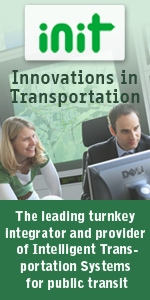

| In This Issue |
| » NEWS HEADLINES |
| » COMMENTARY |
| » LEGISLATIVE ISSUES |
| » TELLING OUR STORY |
| » AROUND THE INDUSTRY |
| » APTA NEWS |
| » PEOPLE ON THE MOVE |

Job opportunities in this issue's classifieds include a public transit agency president/CEO and executive director of a national program!
| NEWS HEADLINES |
U.S. Transit Ridership Tops 10 Billion in 2009; Slight Decrease from 52-Year Historic High in Previous Year
Americans took 10.2 billion trips on public transportation in 2009—the fourth year in a row the figure topped 10 million—according to APTA’s most recent statistics.
The ridership level was just 3.8 percent below the 52-year record set the previous year, despite high unemployment, a severe economic recession, lower gas prices, and bus and rail service cutbacks resulting from lower state and local funding.
“Given last year’s economic hardship, this small decrease in ridership from a record number of ridership trips in 2008 indicates that support for public transit remains strong,” said APTA President William Millar. “Considering that nearly 60 percent of riders take public transportation to commute to and from work, it is not surprising that ridership declined in light of the many Americans who lost their jobs last year.”
APTA noted that, despite this recent decrease in transit ridership, public transportation use is up 31 percent since 1995, a figure that is more than double the growth rate of the U.S. population (15 percent) and up substantially over the growth rate for the vehicle miles traveled on the nation’s highways (21 percent) for that same period.
Millar emphasized that public transit means good “green” jobs in addition to mobility benefits. For every $1 billion invested in public transportation capital and operations, 36,000 jobs are supported and created.
Ridership by Modes
While ridership on light rail overall—modern streetcars, trolleys, and heritage trolleys—decreased 0.4 percent in 2009, two new light rail systems that started service in 2009—Phoenix and Seattle—saw increases. Other light rail systems that showed ridership growth in 2009 are in Baltimore (11.5 percent); Oceanside, CA (10.7 percent); Memphis (9.3 percent); Seattle (9.2 percent); Philadelphia (9.1 percent); Tampa (2.2 percent); San Francisco (1.2 percent); Portland, OR (0.6 percent); and New Orleans (0.1 percent).
Heavy rail, including subways and elevated trains, saw ridership fall 2.6 percent across the country during 2009, but several cities reported ridership increases for the year: Los Angeles (3.9 percent); Chicago (2.2 percent); Philadelphia (1.5 percent); and Washington, DC (0.1 percent).
Nationally, while commuter rail ridership declined by 5.0 percent in 2009, New Mexico Rail Runner Express in Albuquerque, NM—with a new rail line extension in December 2008—saw an increase of 99.5 percent. The two remaining commuter rail systems with annual increases in 2009 were located in Washington, DC (1.9 percent), and Baltimore (0.1 percent).
Large bus systems reported a decrease of 5.2 percent nationally; San Francisco’s bus system showed an increase of 1.2 percent for the year.
Demand-response (paratransit) ridership increased in 2009 by 2.7 percent and trolleybus ridership increased by 0.02 percent.
The complete APTA ridership report is available online.
| « Previous Article | Return to Top | Return to Main | Next Article » |
|
||||||
| AMERICAN PUBLIC TRANSPORTATION ASSOCIATION |
Telephone (202) 496-4800 • Fax (202) 496-4321
Search Back Issues
